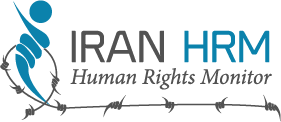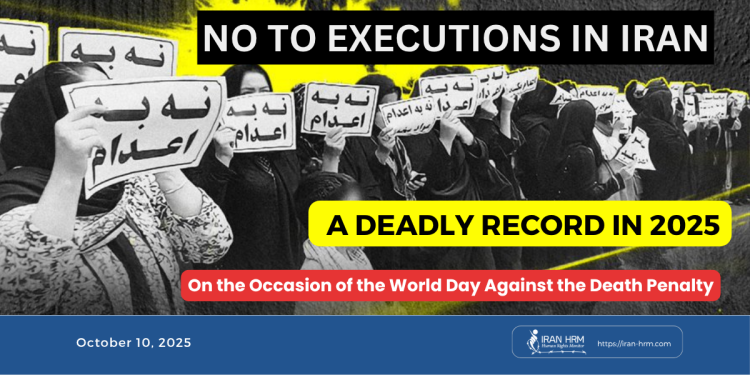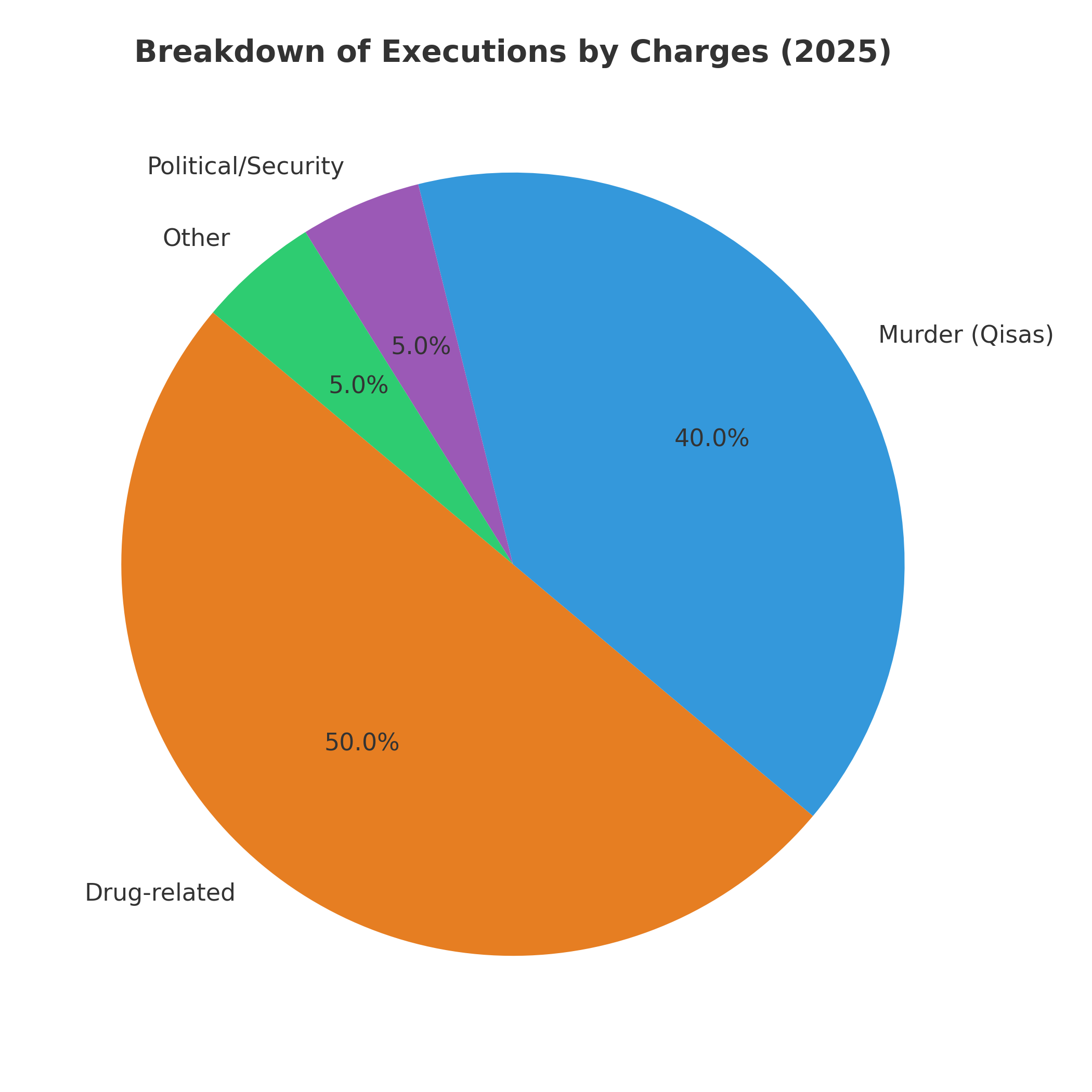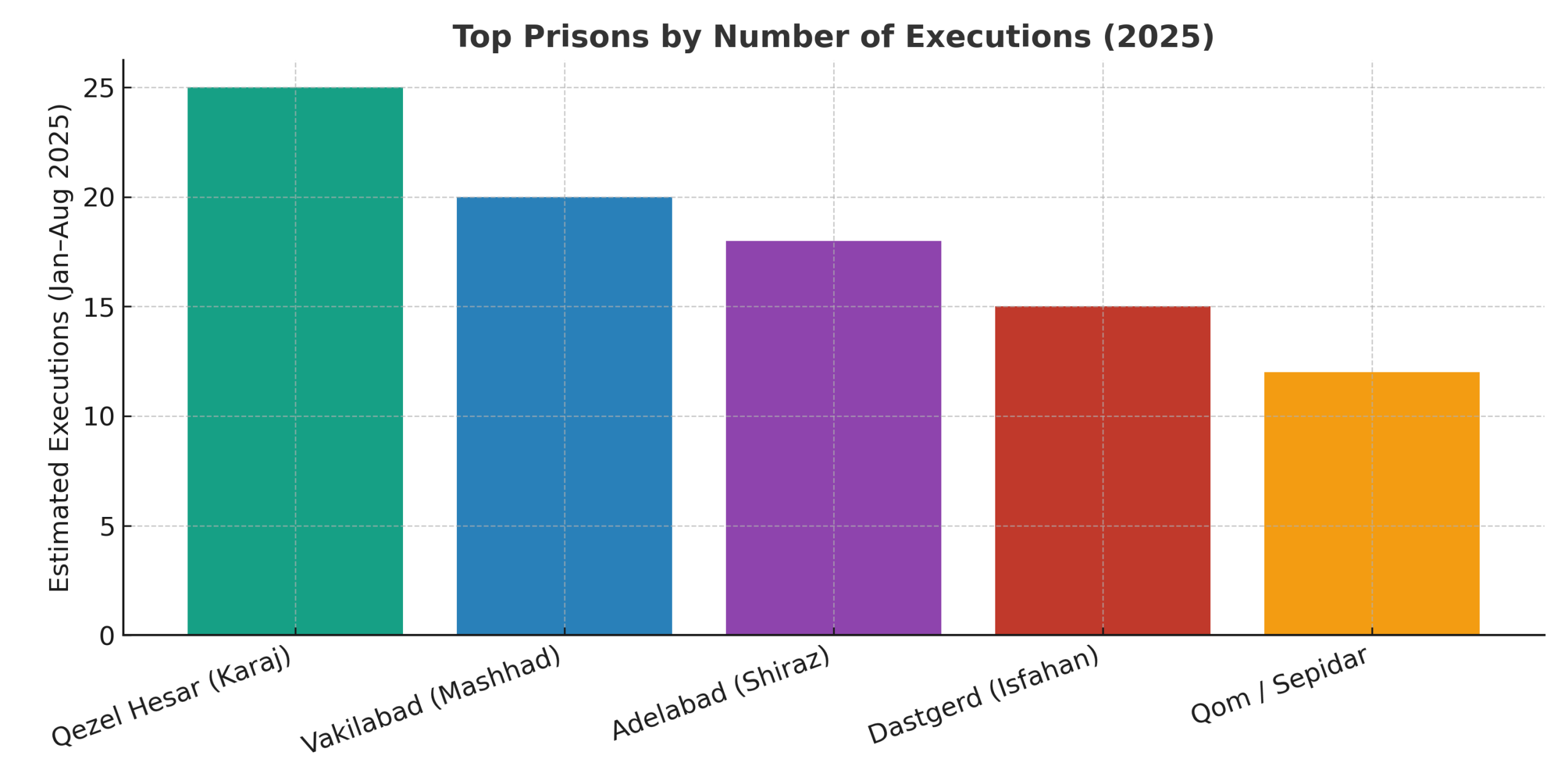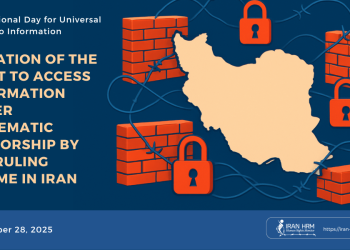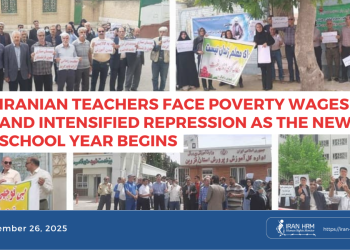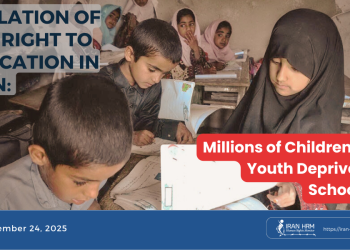The World Day Against the Death Penalty is observed annually on 10 October, launched in 2003 by the World Coalition Against the Death Penalty with support from dozens of human-rights organizations. Its aim is to raise public awareness about the devastating consequences of capital punishment and to promote its universal abolition.
While more than two-thirds of the world’s countries have abolished or suspended executions, the ruling regime in Iran continues to use the death penalty as a tool of control and intimidation. In 2025, Iran once again topped the global ranking and surpassed all other nations in the number of executions. General international reports, including those of Amnesty International, confirmed in late September that the number of executions in Iran this year has exceeded one thousand.
Execution Calendar — 2025
- January – 99 executions
- February – 97
- March – 74
- April – 129
- May – 178
- June – 114
- July – 108
- August – 173
- September – 204
Total confirmed by end of September 2025: 1176 executions.
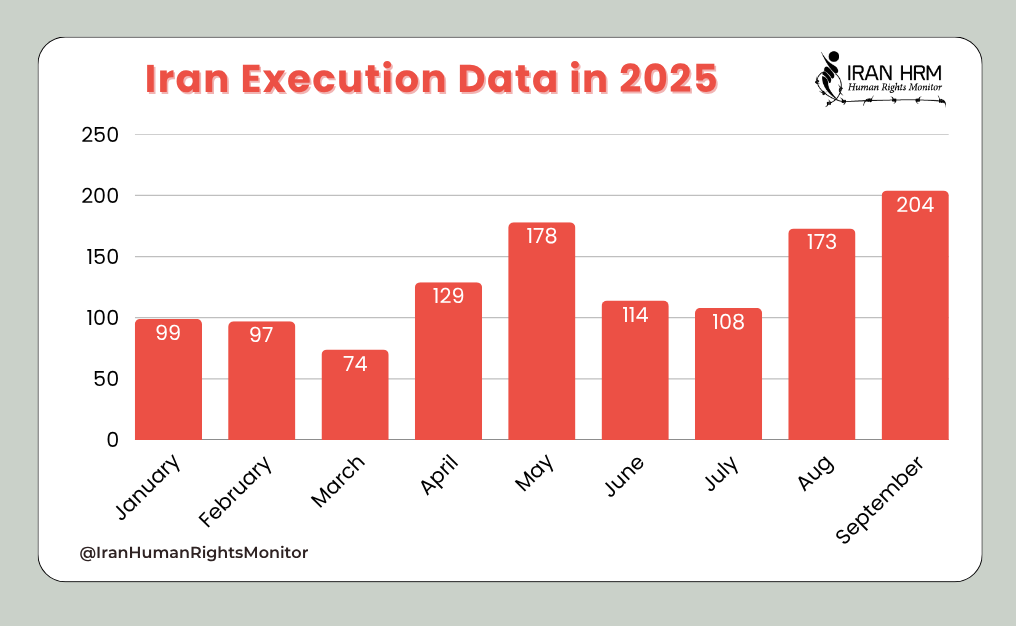
More than half of these executions were related to drug-related offenses, with a significant portion involving murder (qisas) and political or security charges.
The monthly average – over 120 executions -places Iran firmly at the top of the world list.
Victim Profile
The composition of those executed in 2025 reveals that capital punishment in Iran is applied in an arbitrary and discriminatory manner, targeting the poor, women, and political prisoners.
Approximately half of all executions were related to drug offenses, while nearly 40 percent involved murder (qisas). Executions on political or security grounds made up only a small percentage, yet they carry a deep political and social impact.
Among those executed, at least 39 women lost their lives in 2025 – many from impoverished backgrounds or victims of domestic violence. Courts routinely ignored evidence of self-defense or mitigating circumstances rooted in systemic gender violence.
Executions of political prisoners remain one of the most alarming aspects of Iran’s death-penalty crisis. In 2025, three political prisoners -Behrouz Ehsani, Mehdi Hassani, and Mehran Bahramian – were executed on vague charges such as moharebeh and baghi.
In addition, at least 17 other political prisoners remain on death row, most accused of supporting the People’s Mojahedin Organization of Iran (PMOI).
These include Mohammad Javad Vafaei Sani (whose death sentence has been confirmed for the third time), Vahid Bani Amerian, Abolhassan Montazer, Akbar Daneshvarkar, Mohammad Taghavi, Pouya Ghobadi, and Babak Alipour.
Reports of their secret transfers to undisclosed locations in recent months have heightened fears of imminent execution.
Ethnic minorities – including Kurds, Baluchis, Arabs, and Lors – are also disproportionately affected. Analytical data suggest that these minorities constitute more than one-third of those executed in 2025, reflecting entrenched structural discrimination in Iran’s criminal-justice system.
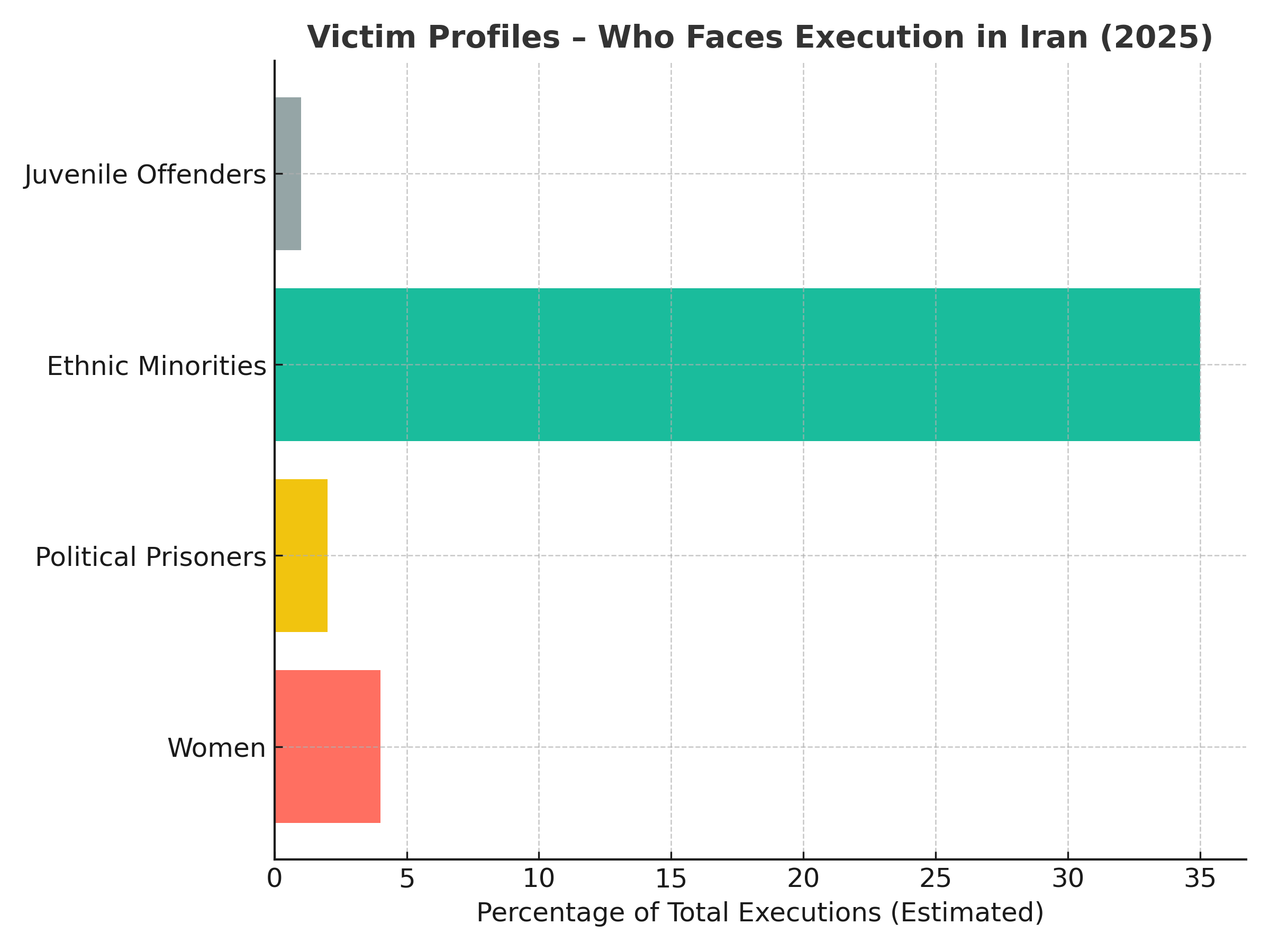 Although Iran is a party to the Convention on the Rights of the Child, reports indicate that juvenile offenders remain on death row. Such cases violate the absolute international ban on the execution of persons who were under 18 at the time of the alleged offense.
Although Iran is a party to the Convention on the Rights of the Child, reports indicate that juvenile offenders remain on death row. Such cases violate the absolute international ban on the execution of persons who were under 18 at the time of the alleged offense.
Overall, the data show that the death penalty in Iran functions as an instrument of fear, discrimination, and social control. Women, minorities, political prisoners, and the poor constitute the main victims, and drug-related crimes continue to account for a large share of executions.
Documented Trends and Systemic Patterns
Executions in Iran occur throughout the country, with three major prisons serving as execution hubs:
- Qezel Hesar Prison (Karaj): primary center for political and security cases.
- Vakilabad Prison (Mashhad): site of frequent group and secret executions.
- Adelabad Prison (Shiraz): one of the most active facilities during summer 2025.
The overall trend demonstrates that the death penalty in Iran has evolved from a judicial measure into a state policy of intimidation and social control.
Secrecy and Lack of Transparency
Judicial authorities classify executions as security matters and withhold essential information — including statistics, names of those executed, and dates of execution.
Fewer than five percent of executions are publicly acknowledged by state media.
Families are often notified only after the body is delivered. Executions are typically carried out at dawn, in silence, without notice to lawyers or final visits from relatives. This practice violates the principles of fair trial and the right of families to information.
Such systematic secrecy serves to prevent public and international scrutiny, eliminating any oversight of judicial processes. The use of the death penalty thus reflects not justice but a policy of fear and political control.
Regional Comparison (Condensed)
While Iran ranks among the top three executing countries in the world in 2025, most neighboring states have abolished or suspended capital punishment. Countries such as Uzbekistan, Turkmenistan, Kazakhstan, Kyrgyzstan, Armenia, and Turkey have not carried out executions for many years. In sharp contrast, Iran remains the only state in the region that uses execution as a daily instrument of political and security control.
International Reactions
Volker Türk — UN High Commissioner for Human Rights
Volker Türk, in multiple statements throughout 2025 (including on 5 July and 30 August), described executions in Iran as a “tool of state terror.”
He stated:
“The death penalty neither ensures security nor delivers justice; it destroys human dignity and erodes public trust in the rule of law.”
Türk called for an immediate moratorium on all executions and warned that charges such as moharebeh (“enmity against God”) and efsad fil arz (“corruption on earth”) are vague and routinely used against protesters and dissidents.
Mai Sato — UN Special Rapporteur on Human Rights in Iran
In her September 2025 report, Mai Sato stated that “in less than nine months, over one thousand people have been executed in Iran — an unprecedented figure in the country’s modern history.”
She stressed that most death sentences are issued by Revolutionary Courts behind closed doors, often based on forced confessions and without fair trial guarantees.
Sato warned that the use of capital punishment for political repression, violence against women, and non-violent crimes such as drug offenses must end immediately.
Amnesty International
On 10 September 2025, Amnesty International warned that Iran’s execution wave had become “a horrifying assault on the right to life,” reporting more than 800 executions since the start of the year.
Two weeks later, on 26 September, Amnesty confirmed that the number had surpassed 1,000 and urged the Iranian authorities to impose an immediate moratorium on all executions.
The organization highlighted that a large portion of these sentences involve drug-related offenses and that many trials failed to meet international fair-trial standards.
Final Analysis and Conclusion
Executions in Iran during 2025 have become a permanent instrument of repression and social control.
Analysis of available data shows that:
- Executions are no longer exceptions but an integral part of the regime’s security policy.
- More than half of the death sentences are for crimes that, under international law, do not meet the threshold of “most serious crimes.”
- Women, minorities, and the poor are disproportionately targeted by this policy.
The year 2025 already stands as the bloodiest in three decades in Iran, marking an unprecedented assault on the right to life.
International Call to Action
Marking the World Day Against the Death Penalty and in line with calls by Volker Türk, Mai Sato, and Amnesty International, the following urgent actions are demanded:
- Immediate moratorium on all executions and a clear roadmap toward abolition.
- Annul death sentences for political and conscience prisoners convicted on vague charges.
- Halt executions for drug-related offenses in violation of Iran’s international obligations.
- Guarantee fair trial standards, including independent legal counsel and public hearings.
- End judicial secrecy and ensure public notification of sentences before execution.
- Eliminate discrimination against women and minorities in sentencing and enforcement of capital punishment.
Silence in the face of this crisis equals complicity in the violation of the most fundamental human right — the right to life. The international community must act now.
